12 Months of Montessori Learning is focusing on geography this week. If you missed what the 12 Months of Montessori Learning is all about, it's a total of 10 amazing Montessori bloggers who have all come together to bring you a different hands-on learning activity for each month. Last month was all about Montessori practical life activities - 6 Practical Life Skills Kitchen Activities. This month is a geography theme and next month will be language arts.
I had SO much fun putting these DIY Montessori inspired sensory habitats together for the geography theme. I picked three very different habitats and created a hands-on sensory bin for each set of animals. The first one is Arctic/Antarctica, second is North American forest animals, and the third is Africa.
FYI: The felt continental maps pictured throughout this post were purchased from the EmIsCrafty Etsy Shop. *Please note that polar bears and penguins are on opposite poles. You may want to make that distinction early on with your children. The point of my blog post was to teach my toddler the differences between three habitats - icy cold, forest green, and dessert oasis.
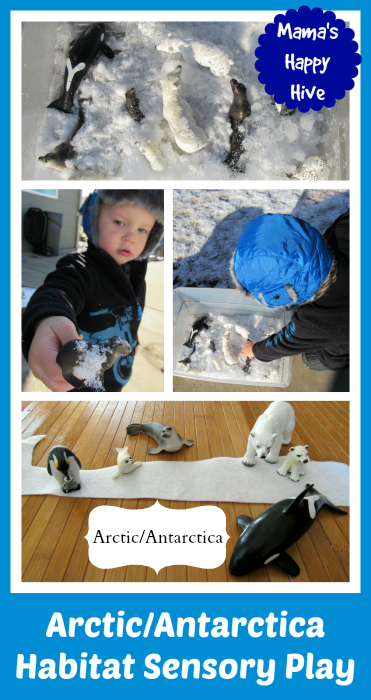
Materials Needed for Arctic/Antarctica Sensory Bin
- Clear plastic tub
- Several Arctic/Antarctic animals
- Crushed Ice (enough to fill the bottom of the tub)
- Handfuls of snow (optional)
- Silver glitter (optional)
I had grand plans for the Arctic/Antarctica sensory bin. I wanted to freeze water mixed with shaving cream to create icebergs and add a little blue food coloring. However, one day I woke up to a dusting of fresh snow outside. I quickly grabbed the tub of Arctic animals and I filled up the bottom of the tub with crushed ice. Then I ran outside to add several handfuls of fresh snow before the sunshine melted it. I also added a few sparkles of silver glitter. It was warm enough outside that Little Bee was able to play with his icy cold sensory tub with his bare hands. The sensory bin was simple, yet it still helped Little Bee learn about an icy cold habitat for his animals.
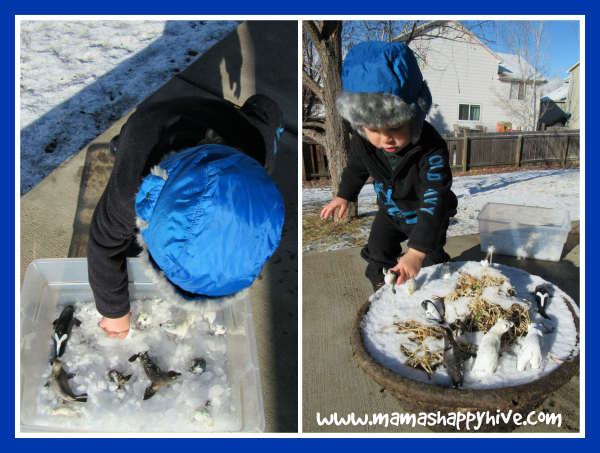
It's really wonderful to set up an invitation to play activity and then watch as the toddler creates his own play ideas. Little Bee enjoyed playing in his icy sensory bin for awhile and then he thought up, on his own, to place all his animals into the snowy planter nearby. As he carefully transferred each animal to the planter, I talked with him about that animal and why it was special. I really liked how he arranged each animal into the planter. He made sure each one stood up straight and was evenly spaced out. It's amazing to see how his little brain works and to observe his love for order.
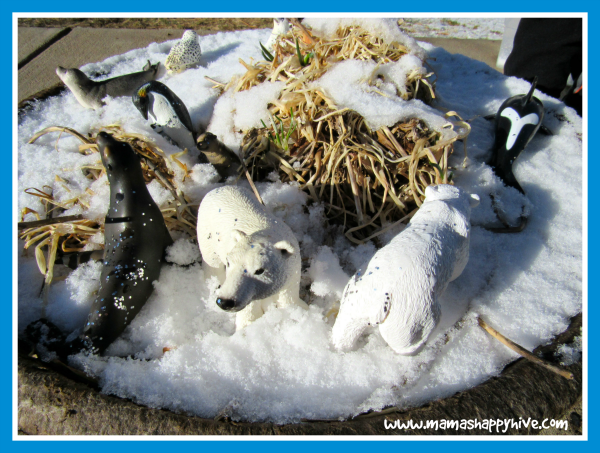
Our next sensory bin was filled with North American forest animals. I wanted to create a bin that had materials and colors that would be found in the forest. At Michael's I found a bag of four varieties of real moss. I also found green and brown crinkle paper for the filler. I added the pinecones and plastic pine trees to complete the forest theme. Little Bee carefully took his animals out of the box to line them up in a row on the living room floor. As he took them out of the sensory bin, I talked to him about each animal and how they live in a forest habitat.
Materials Needed for the North American Forest Sensory Bin
- Clear plastic tub
- Several Forest Animals of North America
- Planting soil to fill the bottom of the tub or green and brown shredded paper
- Plastic pine trees (optional)
- Any natural thing that you find outside that represents the forest - acorns, dried or fresh grass, moss, bark, pinecones, rocks, twigs and small branches
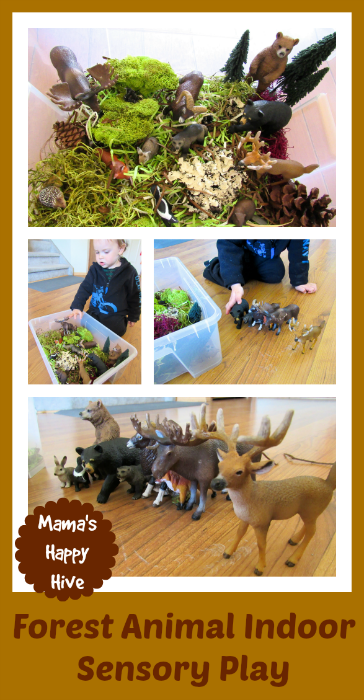
After playing for awhile indoors with the forest animals, I decided it would be wonderful to actually take them outside and create a sensory bin with real forest materials. Little Bee helped me gather branches and then pour dark earthy soil into the bin.
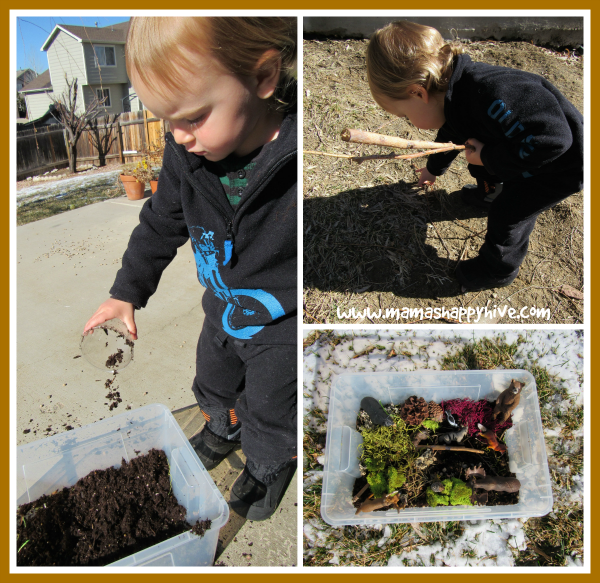 The end result of this earthy natural forest habitat was amazing! It looked and smelled wonderful. Little Bee enjoyed finding his camouflaged animals hidden within the soil, moss, pinecones, and branches.
The end result of this earthy natural forest habitat was amazing! It looked and smelled wonderful. Little Bee enjoyed finding his camouflaged animals hidden within the soil, moss, pinecones, and branches. 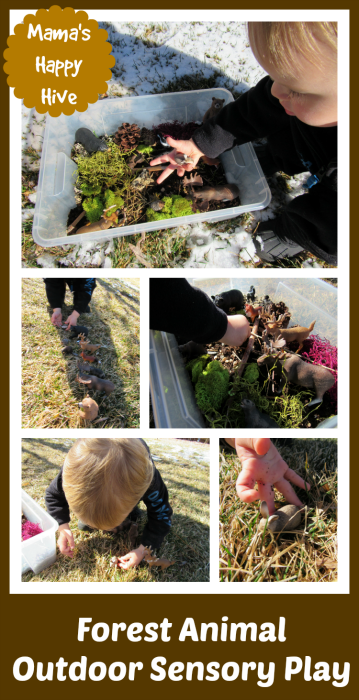
Doesn't this little Schleich beaver look real in his natural environment?
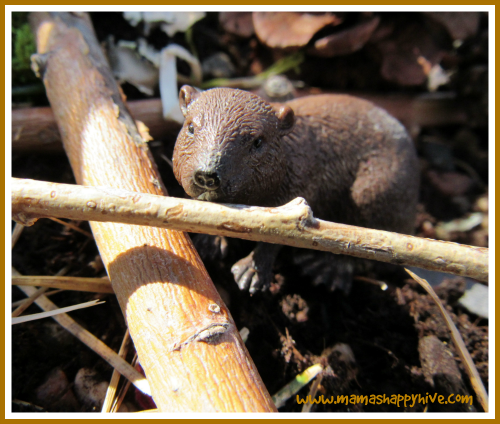
The last habitat sensory bin was about life in an African desert environment with a small watering hole for all the animals. I talked to Little Bee about the life-cycle and needs of the animals in Africa. I explained that all the animals need to take a drink of water in order to live. However, there are crocodiles waiting in the water. The crocodiles like to eat some of the animals who come to take a drink for lunch or dinner. Little Bee didn't like that part and took the crocodile out of the sensory bin. Then he proceeded to bring each animal to the watering hole for a drink.
Materials Needed for the African Sensory Bin
- Clear plastic tub
- Several African animals
- Play Sand (enough to fill the bottom of the tub)
- Shaving cream (optional)
- Wide yet short sided bowl for the watering hold (fill with water)
I added shaving cream to the play sand to increase the sensory experience for Little Bee while playing with the sand. The sand foam idea was inspired by the Paging Fun Mums blog - Sand Foam Two Ingredients for Super, Sensory Fun. Adding the shaving cream to the sand helped to condition the sand so that is wasn't as drying for the hands while playing with it. Plus, it gave the sand a cool moist feeling, kind of like sand by the seashore. The more shaving cream that was added, the foamier the sand became. Little Bee loved helping me prepare the sand foam environment for his African animals and he was in his full toddler moment of messy joy!
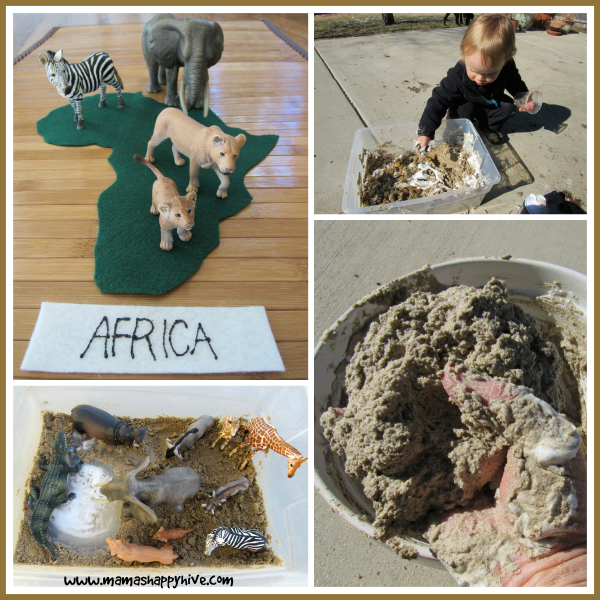
Here are several photos from inside the African sensory bin. You can see the animals coming for a drink and the hungry crocodile is waiting for dinner.
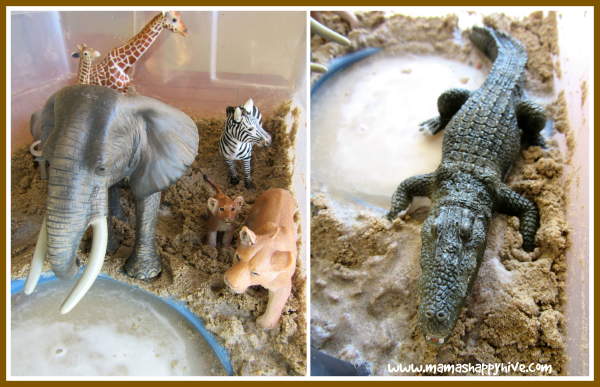 Little Bee had all the animals take a drink from the watering hole. Some of the animals literally dived into the water hole and a few took a nice roll in the mud. Overall, I think this was Little Bee's favorite sensory bin of the three habitats that we explored. It was a lot of messy fun!
Little Bee had all the animals take a drink from the watering hole. Some of the animals literally dived into the water hole and a few took a nice roll in the mud. Overall, I think this was Little Bee's favorite sensory bin of the three habitats that we explored. It was a lot of messy fun!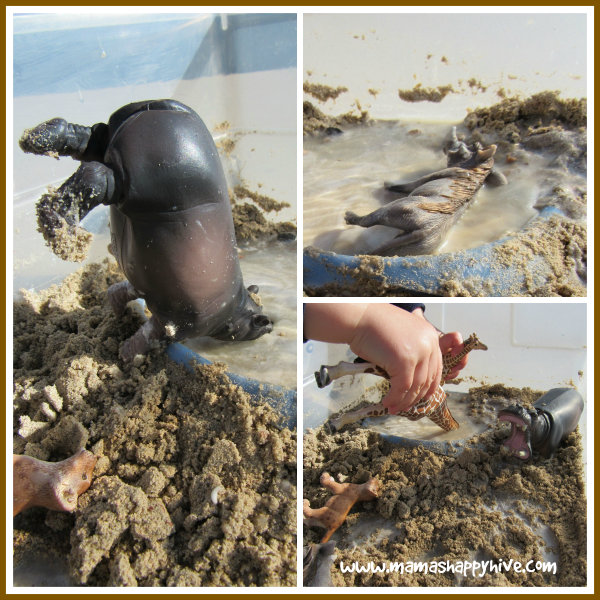
I hope you enjoyed our three distinctly different sensory bins from the cold polar regions of the Arctic to the watering holes of Africa. Thanks for your visit.
Follow Vanessa @'s board ~ Mama's Happy Hive ~ Blog on Pinterest.

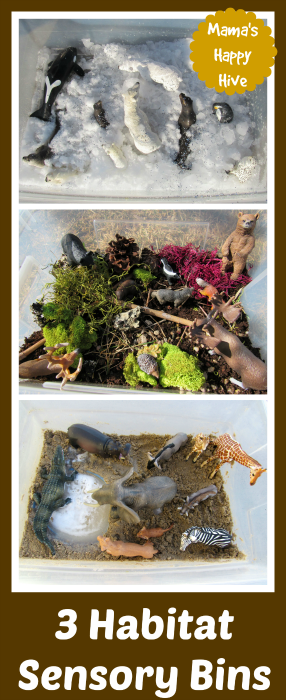
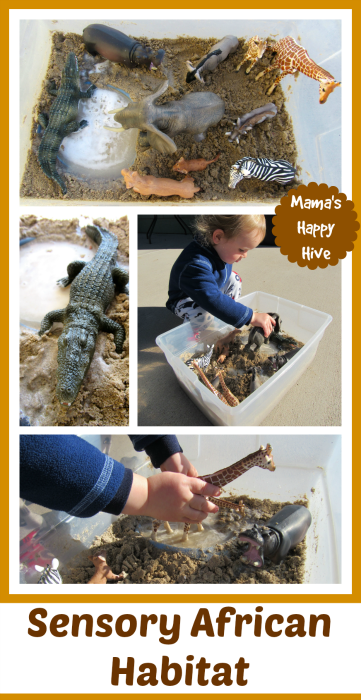
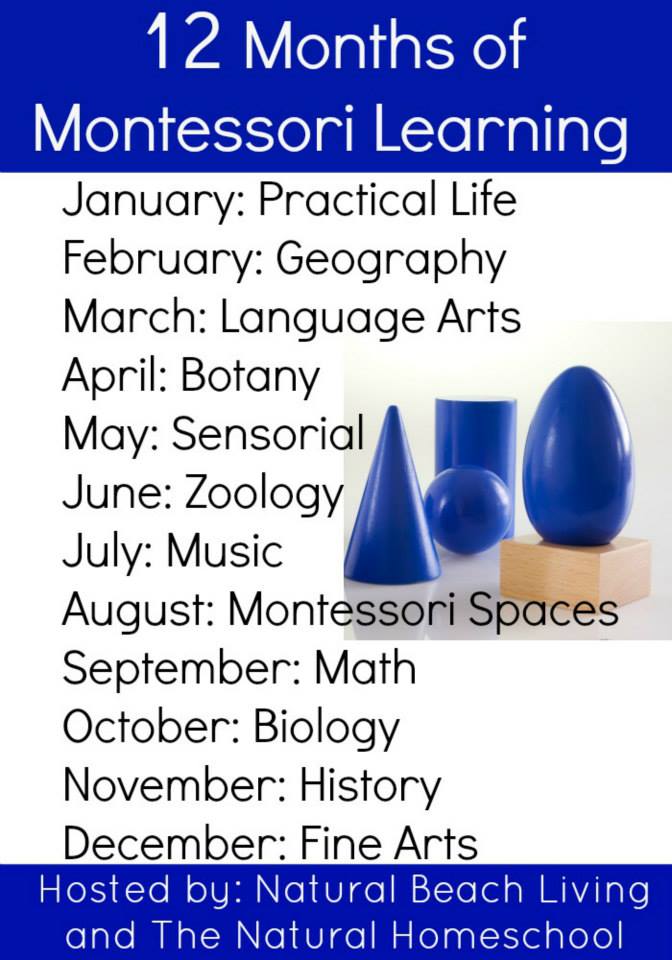

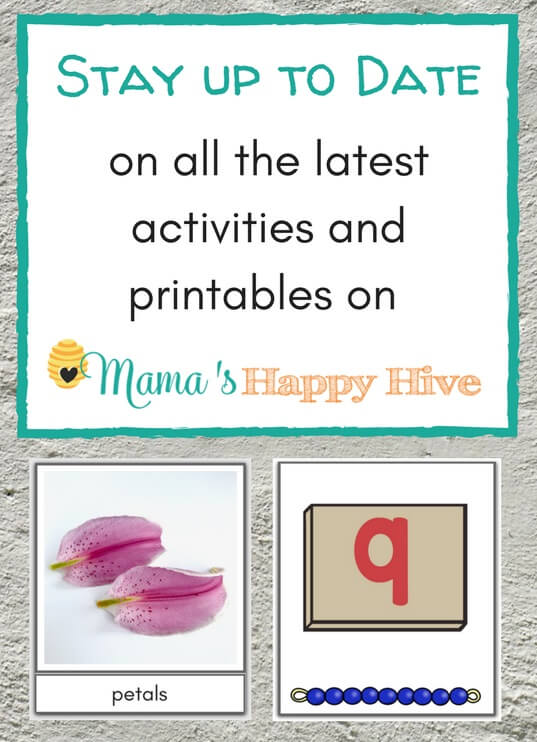
Wow Vanessa! I loooove your Schleich collection!! I love them… they’re more sturdy and waay bigger than the toobs but they’re pretty expensive so I chose the toobs. Though I own a few of them as well. That’s my ultimate dream to have Schleich collection like yours! And looove your habitats! Makes me want to make a habitat of own as well.
These are fabulous and absolutely adorable! I love that you included pictures of the actual play.
LOVE that you took the time to observe his love of order. And how cute are those animals taking drinks of water? I think that would be my kids’ favourite bin, too!
Oh my goodness! This is such a cute lesson! I love the outdoors in weather like this! Might as well make it educational, right?
I can’t tell you how great this is! I love all the habitats. I know it took a lot of work to put all these wonderful pictures together. Thank you for sharing with us!
Vanessa, you can actually make your map though. I made two versions: felt and foam craft. I used a knife so I can cut them precisely and a template which you can download in the web.
I love the idea to add habitats for the animals. Thanks for sharing your ideas of how you did so. I wanted to make note though that polar bears do not live in Antarctica. I noticed you mentioned Arctic/Antarctica and this maybe it would be good to include a globe and a map piece of the Arctic too if you’re going to talk about them together. It’s a strong visual to see a polar bear on a map piece of Antarctica. Which is why your idea to do so is great so that children gain this strong impression, but we do want it to be accurate. It is a common misconception that polar bears and penguins live in the same place. http://www.polarbearsinternational.org/polar-bear-facts-information/where-do-polar-bears-live
Thanks Carrie! I’ll look into this.
The bins are amazing and you have truly inspired me. I never would have through to explore biomes that way.
I thought I had already commented, but this was really a lovely post I’m working on setting up something for my son using this idea for our study of Africa
I’m working on setting up something for my son using this idea for our study of Africa  He’s going to love it!
He’s going to love it!
Thank you Yuliya! I appreciate all your feedback and support. This was a really fun post to put together for my son.
These are fabulous! Looks like your son had lots of fun!!
He sure did! Thanks for stopping by Anastasia!
How lovely!
Oh how I like this post! You have worked hard to make it look so natural! Learning with full dipping into the subject!
Thank you Katherine!
What fun activities! I know my 3-yo would love this too! It’s funny because we were just making the distinction of polar bear vs penguins and arctic vs antartica where they live exclusively this morning over breakfast. We learned something new as parents today, so maybe I wont’ be so nervous about the distinction at his young age (besides, I think he’ll be downright distracted by all the snow and singing the continent song he won’t even notice) Lovely post! Sharing and pinning!
Lovely post! Sharing and pinning!
This looks like so much fun. I’m not sure if my son is quite old enough to understand everything yet, but he would love the opportunity to dig through these!
Thanks for stopping by and commenting! I hope your son loves this sensory experience!
Love this! Will feature this in Learn & Play Link Up this week. Thank you for sharing!
Thank you for the feature!
What a fun way to connect your kids to all of the continents. I bet they loved the experiences.
Yes! Little Bee loved getting his hands dirty.